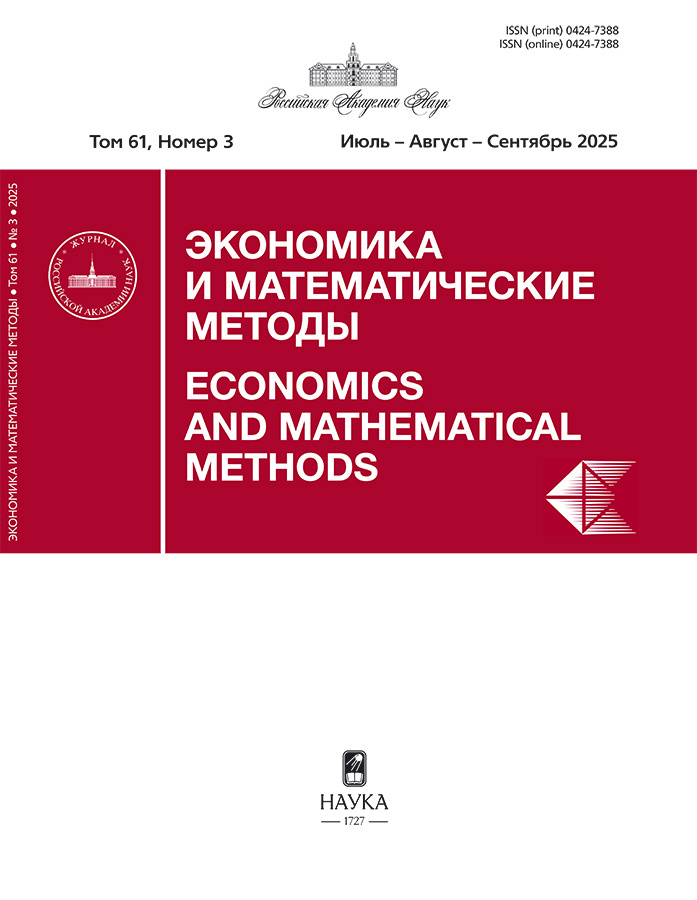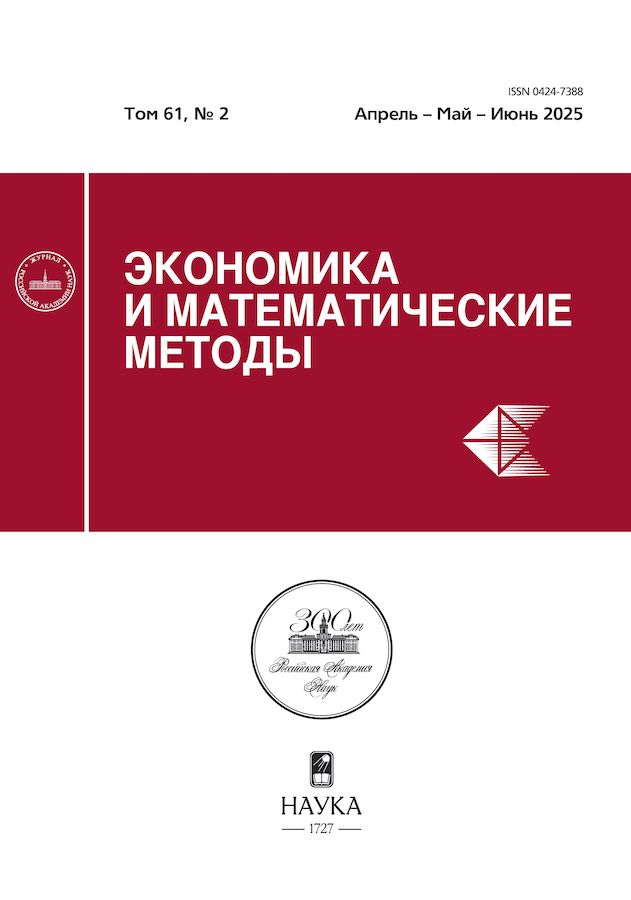Влияние изменения ключевой процентной ставки на ипотечные ставки в регионах России
- Авторы: Демидова О.А.1, Щанкина А.А.1
-
Учреждения:
- НИУ «Высшая школа экономики»
- Выпуск: Том 61, № 2 (2025)
- Страницы: 75-89
- Раздел: Региональные проблемы
- URL: https://vestnik.nvsu.ru/0424-7388/article/view/684415
- DOI: https://doi.org/10.31857/S0424738825020061
- ID: 684415
Цитировать
Полный текст
Аннотация
В статье рассмотрен процентный канал монетарной трансмиссии влияния денежно-кредитной политики Банка России на средневзвешенную ипотечную ставку, публикуемую на сайте Банка России, и коммерческую ипотечную ставку, рассчитанную авторами за вычетом кредитов по ряду программ: льготной, семейной, дальневосточной, арктической и ипотечной для ИТ-специалистов. Основная гипотеза, проверяемая в статье, состояла в том, что реакция ставок по ипотечным кредитам на изменение курса денежно-кредитной политики Банка России неодинакова в разных регионах России и в разные промежутки времени. Для проверки данной гипотезы была использована модель коррекции ошибок (ECM), оцененная на ежемесячных данных по 85 регионам России с января 2016 г. по август 2023 г. Полученные нами результаты показали, что до COVID-19 (январь 2016 г. — февраль 2020 г.) долгосрочная связь ипотечных ставок со среднемесячной фактической ставкой по межбанковским кредитам (Moscow Interbank Actual Credit Rate, MIACR) и подстройка к долгосрочному равновесию были обнаружены в большинстве регионов (76 регионов для средневзвешенных и 61 регион для коммерческих ставок). COVID-19 примерно одинаково сильно повлиял на трансмиссию средневзвешенной и коммерческой ставок — с января 2016 г. по февраль 2022 г. она сохранилась в 4 и 14 регионах соответственно. Шок СВО (по оценке на данных до августа 2023 г.) сильнее повлиял на трансмиссию средневзвешенной ставки, чем на трансмиссию коммерческой ставки (она сохранилась в 5 и 30 регионах соответственно). Монетарная трансмиссия — это совокупность каналов передачи импульсов изменения ключевой ставки центрального банка к объему ликвидности и экономической активности агентов. Воздействие монетарной политики на ипотечные ставки различается по регионам: до COVID-19 в европейской части России средневзвешенная ипотечная ставка реагировала на изменение MIACR в основном в том месяце, когда имел место шок, а в Сибири и на Дальнем Востоке — в следующем месяце, что может быть вызвано большим числом посредников.
Полный текст
Об авторах
О. А. Демидова
НИУ «Высшая школа экономики»
Автор, ответственный за переписку.
Email: demidova@hse.ru
Россия, Москва
А. А. Щанкина
НИУ «Высшая школа экономики»
Email: annachankina@yandex.ru
Россия, Москва
Список литературы
- Ахметов А., Морозов А., Поршаков А., Чернядьев Д. (2021). Об оценке потенциального спроса на ипотеку. Аналитическая записка // Банк России. Режим доступа: https://cbr.ru/content/document/file/131065/analytic_note_20211129_dip.pdf [Akhmetov A., Morozov A., Porshakov A., Chernyadyev D. (2021). On the assessment of potential demand for mortgages. Analytical note. Website of the Bank of Russia. Available at: https://cbr.ru/content/document/file/131065/analytic_note_20211129_dip.pdf (in Russian).]
- Егоров А. В., Борзых О. А. (2018). Асимметрия процентного канала денежной трансмиссии в России // Экономическая политика. Т. 13. № 1. С. 92–121. doi: 10.18288/1994-5124-2018-1-04 [Egorov A. V., Borzykh O. A. (2018). Asymmetric interest rate pass-through in Russia. Economic Policy, 13, 1, 92–121. doi: 10.18288/1994-5124-2018-1-04 (in Russian).]
- Гафарова Е. А. (2023). Гетерогенность канала рефинансирования ипотеки в российских регионах // Финансы: теория и практика. Т. 27. № 4. С. 184–193. doi: 10.26794/2587-5671-2023-27-4-184-193 [Gafarova E. A. (2023). Heterogeneity of mortgage refinancing channel in the Russian regions. Finance: Theory and Practice, 27, 4, 184–193. doi: 10.26794/2587-5671-2023-27-4-184-193 (in Russian).]
- Леонтьева Е. А. (2016). Механизм кредитно-денежной трансмиссии в России. Препринт РЭШ. WP175/2016. М: ЦЭФИР / РЭШ. [Leontieva E. A. (2016). The mechanism of monetary transmission in Russia. NES Working paper, WP175/2016. Moscow: CEFIR / NES. 87 p. (in Russian).]
- Иванова Н. С., Попова С. В., Стырин К. А. (2024). Концентрация рынка банковского кредитования и трансмиссия денежно-кредитной политики: о чем говорят данные кредитного регистра // Серия докладов об экономических исследованиях. Банк России. № 123. [Ivanova N. S., Popova S. V., Styrin K. A. (2024). The concentration of the bank lending market and the transmission of monetary policy: What the data of the credit register indicate. A series of reports on economic research. The Bank of Russia, 123 (in Russian).]
- Иванова Н. С., Петренева Е. А., Стырин К. А., Ушакова Ю. В. (2023). Влияние денежно-кредитной политики США в условиях низких процентных ставок на деятельность российских банков // Серия докладов об экономических исследованиях. Банк России. № 114. [Ivanova N. S., Petreneva E. A., Styrin K. A., Ushakova Yu.V. (2023). The impact of US monetary policy in the context of low interest rates on the activities of Russian banks. A Series of Reports on Economic Research. The Bank of Russia, 114 (in Russian).]
- Коновалова А., Коршунов М., Нестерова М., Скуратова А., Устинов А. (2021). Реакция банковских ставок на изменение ключевой ставки Банка России в условиях региональной неоднородности. Аналитическая записка. Сайт Банка России. Режим доступа: https://cbr.ru/Content/Document/File/131898/analytic_note_20211224_cfo.pdf doi: 10.2139/ssrn.4890994 [Konovalova A., Korshunov M., Nesterova M., Skuratova A., Ustinov A. (2021). Reaction of bank rates to changes in the key rate of the Bank of Russia in conditions of regional heterogeneity. Analytical note. Website of the Bank of Russia. Available at: https://cbr.ru/Content/Document/File/131898/analytic_note_20211224_cfo.pdf doi: 10.2139/ssrn.4890994 (in Russian).]
- Моисеев С. Р. (2002). Трансмиссионный механизм денежно-кредитной политики // Финансы и кредит. № 18 (108). С. 38–51. [Moiseev S. R. (2002). Transmission mechanism of monetary policy. Finance & Credit, 18 (108), 38–51 (in Russian).]
- Моисеев С. Р. (2020). Реинкарнация RUONIA, или вторая жизнь процентного индикатора. // Банковское дело. № 7. С. 20–27. [Moiseev S. R. (2020). The reincarnation of RUONIA, or the second life of the percentage indicator. Banking Business, 7, 20–27 (in Russian).]
- Приставко А. С. (2021). Теоретические основы функционирования процентного канала монетарной трансмиссии // Журнал Белорусского государственного университета. Экономика. № 2. С. 48–58. [Prystauka A. S. (2021). Theoretical basis of monetary transmission interest rate channel functioning. Belarus State Economic University Journal. Economics, 2, 48–58 (in Russian).]
- Салманов О. Н., Заернюк В. М., Лопатина О. А. (2017). Особенности функционирования каналов денежно-кредитной трансмиссии до и после финансового кризиса // Экономический анализ: теория и практика. Т. 16. № 7 (466). С. 1317–1336. [Salmanov O. N., Zaernyuk V. M., Lopatina O. A. (2017). Specifics of monetary transmission channels’ operation before and after the financial crisis. Economic Analysis: Theory and Practice, 16, 7 (466), 1317–1336 (in Russian).]
- Синельникова-Мурылева Е., Ульянкин Ф. (2016). Эволюция взглядов на каналы денежно-кредитной трансмиссии // Экономическое развитие России. Т. 23. № 10. С. 17–22. [Sinelnikova-Muryleva E., Ulyankin F. (2016). The evolution of views on the channels of monetary transmission. Russian Economic Development, 23, 10, 17–22 (in Russian).]
- Koeniger W., Lennartz B., Ramelet M. A. (2022). On the transmission of monetary policy to the housing market. European Economic Review, 145, 104107. doi: 10.1016/j.euroecorev.2022.104107
- Mishkin F. S. (1995). Symposium on the monetary transmission mechanism. Journal of Economic Perspectives, 9, 4, 3–10. doi: 10.1257/jep.9.4.3
- Mishkin F. S. (2006). Monetary policy strategy: How did we get here? NBER Working Papers, 12515. doi: 10.3386/w12515
- Oyadeyi O. (2023). Financial development, interest rate pass-through and interest rate channel of monetary policy. Cogent Economics & Finance, 11, 1, 2209952. doi: 10.1080/23322039.2023.2209952
- Scharfstein D., Sunderam A. (2014). Market power in mortgage lending and the transmission of monetary policy. Harvard Business School Working Paper, formerly “Concentration in Mortgage Lending, Refinancing Activity, and Mortgage Rates,” NBER Working Papers, 19156.
Дополнительные файлы





















